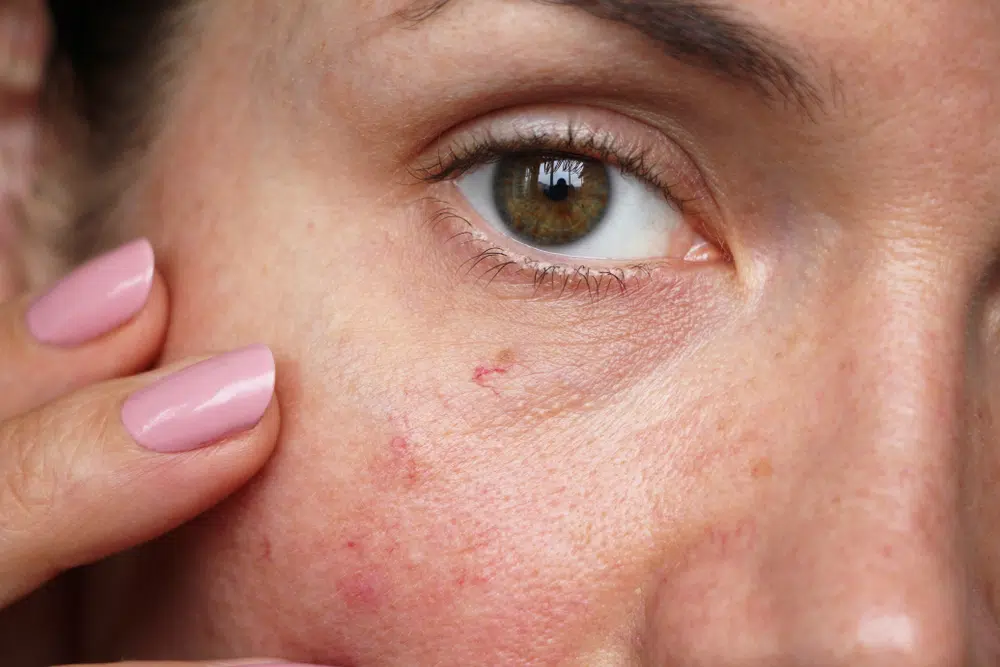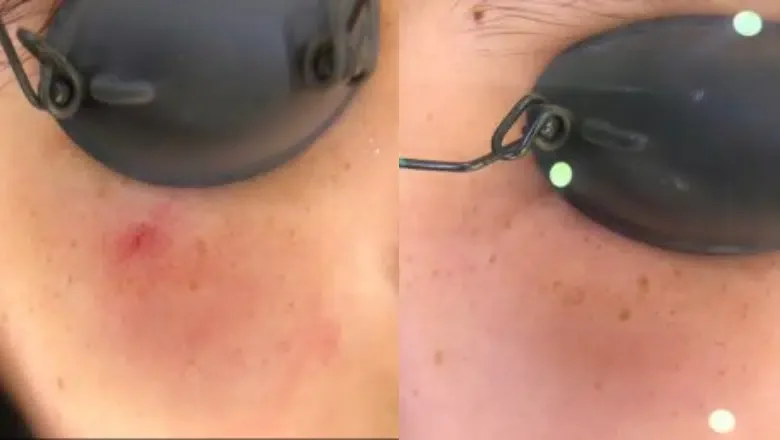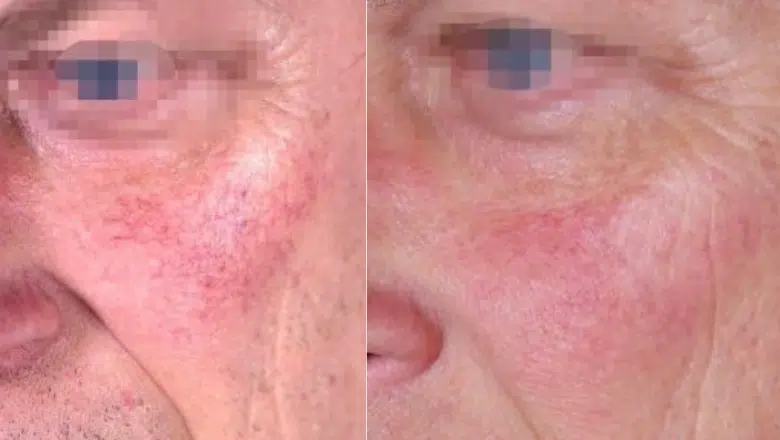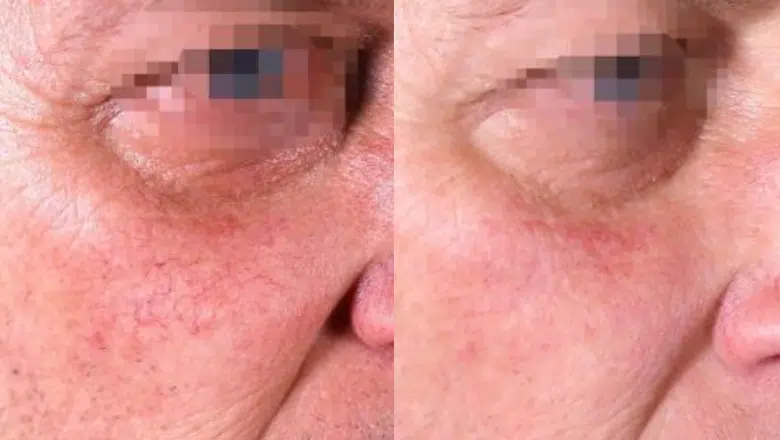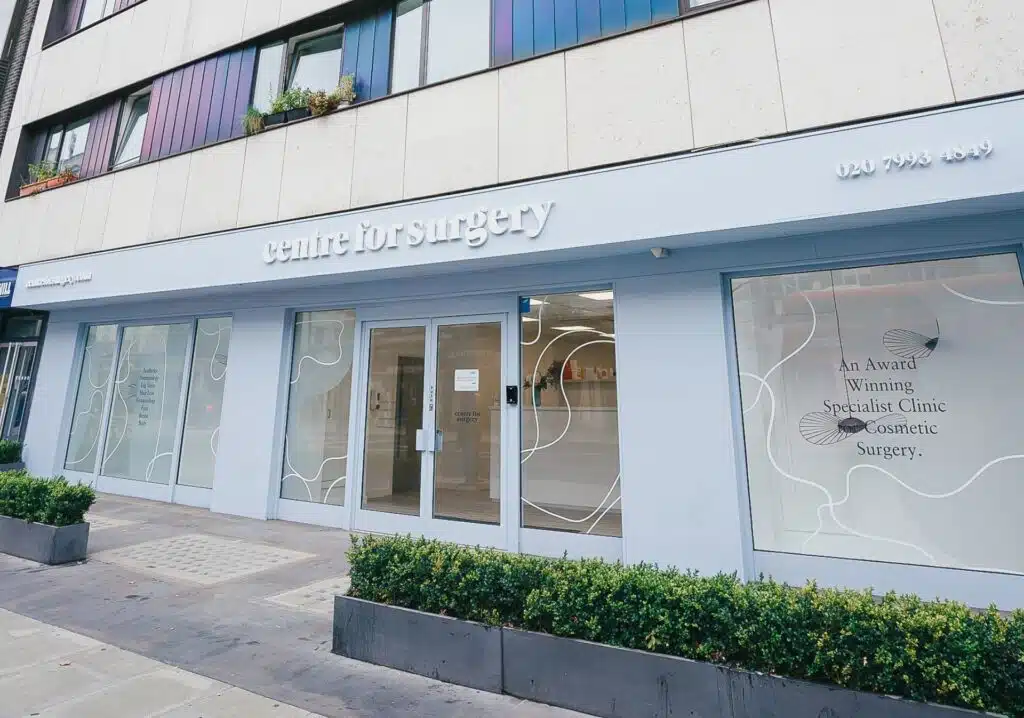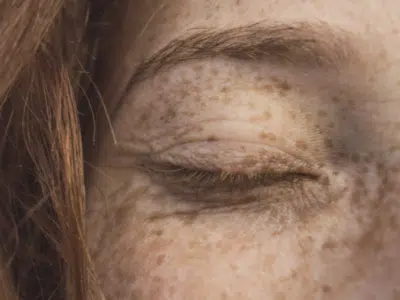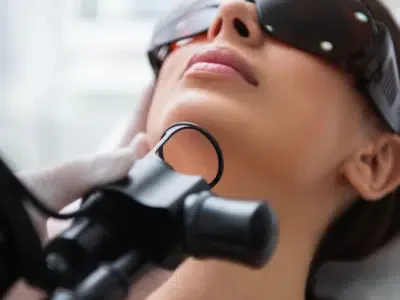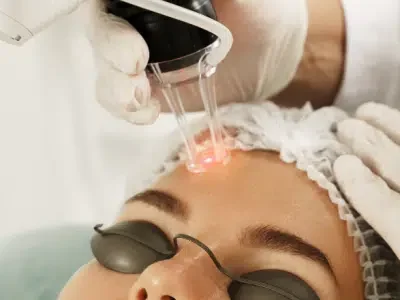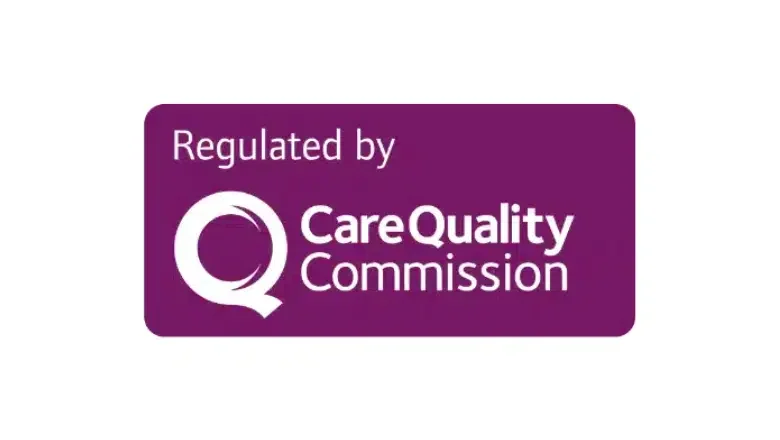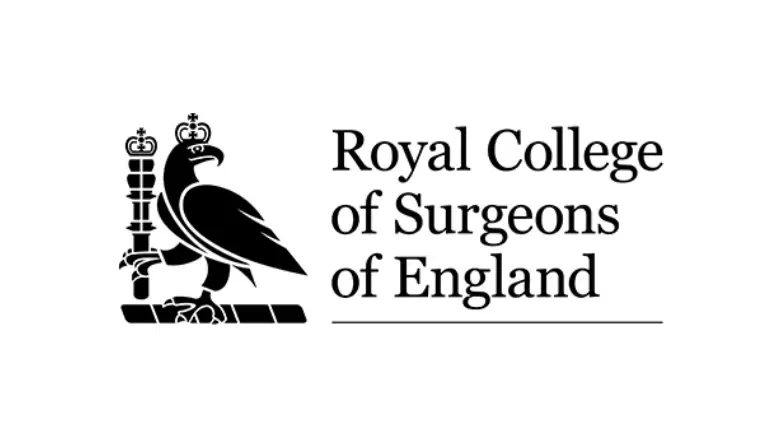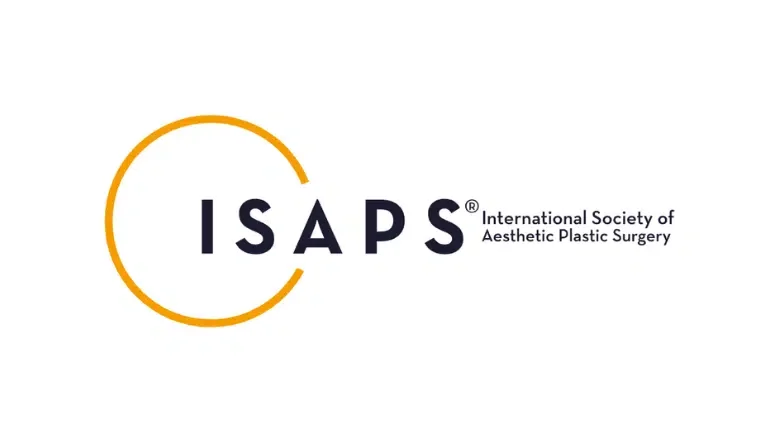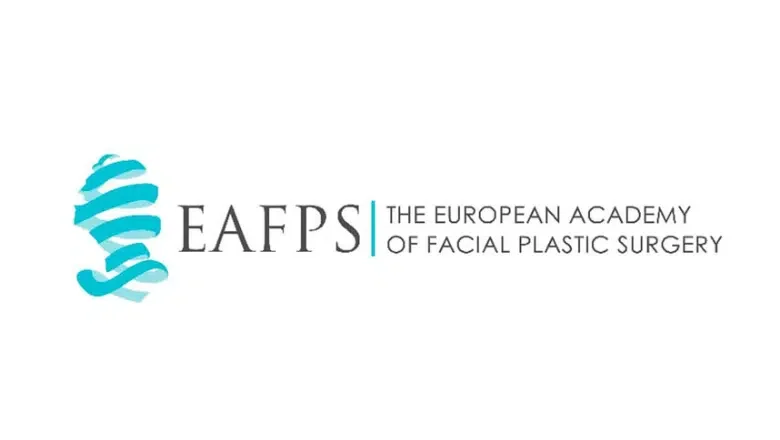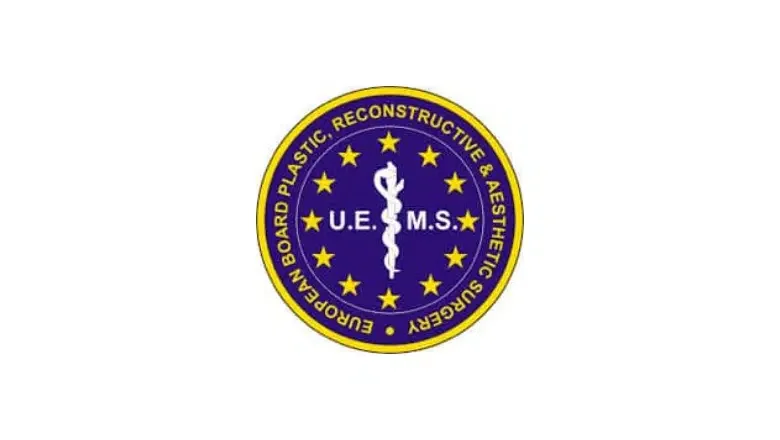Facial thread vein removal in London
Revitalise your skin’s appearance with Centre for Surgery’s laser thread vein removal, a cutting-edge solution for a clearer, more youthful facial complexion
Facial Vein & Spider Naevi Treatment
Facial thread vein removal before and after
Case 1:
Case 2:
This 62-year-old man presented in the clinic concerned about the “broken capillaries” on his face, mostly his cheeks. He had not been treated for this problem before. The treatment plan was to use Nd YAG laser to reduce or altogether remove the facial thread veins for him. No special pre-treatment was used. The laser technique involved using high energy, small spot size, extensive contact (ice cubes) and cold air cooling for the best possible results with minimal sessions. Most of the blood vessels were removed with one session, but a second treatment was also performed to improve the outcome. The patient described discomfort as 2 out of 10, and a steroid ointment was applied immediately after the procedure. The patient was advised to limit sun exposure for 10-14 days after laser treatment and use SPF 30 and higher sun protection when in the sun.
Causes of Facial Thread Veins
Hereditary factors – Many patients Have a genetic predisposition to the development of facial thread veins and they may have members of the family who already have veins on the face.
Ageing process – with ageing the skin begins to lose its elasticity and therefore becomes thinner. This can result in superficial veins of the face becoming more visible beneath the skin.
Rosacea – many patients who suffer from rosacea are more likely to develop facial thread veins as this is often due to the facial redness and overactive circulation caused by rosacea, resulting in larger facial veins.
Facial thread veins can also appear following increased pressure in the face, which may temporarily arise from a rigorous bout of sneezing, blowing one’s nose or vomiting. Older patients who have had a recent illness may develop small broken capillaries as a result of excessive coughing and sneezing
Chronic sun exposure – patients who spend large amounts of time in the Sun can be susceptible to increased free radical damage, and this can directly result in facial veins becoming larger and, with the added combination of thinner skin, more visible.
Environmental factors – the formation of facial veins on the face can also be linked with excessive exposure to certain noxious chemicals or pollutants found in the environment, such as smog.
Temperature changes – significant and large increases or decreases in temperature can affect the microcirculation in the face. Many patients may develop facial flushing as a result of temperature spikes, and this can lead to facial veins rupturing leading to the formation of spider veins or telangiectasia
Traumatic injury – patients can develop localised bruising following an injury to the face. As part of the healing process, the face may become red and be linked with the formation of broken capillaries; however, in virtually all cases, these prominent blood vessels disappear as healing takes place.
Lifestyle factors – common lifestyle factors which may be linked with facial thread veins include a sedentary lifestyle and highly stressful types of work. Visually intensive tasks such as sitting at a computer may lead to eyestrain and insomnia and a possible increased risk of facial thread vein formation as a result.
Pregnancy – women experience significant hormonal changes during pregnancy, which may cause an increased formation of broken capillaries visible beneath the skin. This is most commonly a pregnancy-related phenomenon and results fully with childbirth.
Alcohol intake – patients who drink large quantities of alcohol excessively may develop significant and chronic broken capillaries, which may coexist with spider veins and telangiectasia in association with possible rosacea and facial redness.
RELATED: What Causes Facial Thread Veins?
What are Spider Naevi?
Spider naevi are small, enlarged blood vessels located beneath the skin’s surface. They take on the appearance of the small central red dot with thin red blood vessels that emanate from the central spot. The spidery appearance explains their name, spider naevi, also known as spider angioma. Spider naevi are treated in the same way as any other facial thread vein.
Laser treatments are now considered a routine way to remove vascular lesions from the face.
Centre for Surgery uses Fotona’s long-pulse Nd:YAG laser to remove vascular lesions. This laser can penetrate 5 to 6mm into the skin, making treatment a highly effective way to cause lesion regression.
How Does Face Thread Vein (Spider Vein) Laser Treatment Work?
Ideal candidates for Facial Thread Vein removal
You will be a suitable candidate for facial thread vein removal if you have vascular lesions on your face that you wish to remove using a long pulse Nd:YAG laser.
It would be best if you had realistic expectations about what the procedure can achieve.
Before undergoing facial thread vein removal, you will need to attend a consultation with one of our practitioners, who will be able to assess whether or not you are a suitable candidate for facial thread vein removal.
Facial thread vein removal procedure
Nd:YAG Laser is the gold standard in treating facial thread veins, and treatment is quick and efficient. Simple cases can be done in a single treatment. More complex cases may take 2-3 treatments. Laser removal of vascular lesions involves using Fotona’s powerful Nd:YAG laser.
This laser emits energy absorbed by the blood in the vein. This is then converted into heat, destroying the walls of the vein. The body then naturally absorbs the dead tissue, and other healthy veins supply blood to the region. As a result of this, the vascular lesions then become less visible.
The laser includes VSP (Variable Square Pulse) technology, which controls the temperature increase and ensures minimal energy is transmitted into other areas, meaning your skin is better protected from unintended injury. This is a safe, fast and effective method of removing vascular lesions.
You may require multiple treatments to see the desired results. This will depend on the size of the lesions and how many there are. However, most patients will be able to see significant results after one treatment. As this is a non-invasive procedure, it has no downtime. You may experience some slight redness or discomfort in the treatment area.
How Much Does Laser Thread Vein Removal Cost?
The cost for laser thread vein removal varies based on the extent of the area requiring treatment and the number of sessions needed. A detailed cost breakdown will be provided after an initial consultation to assess your specific needs. Below is a general pricing guide:
| Area Treated | 1 Session | 3 Sessions |
|---|---|---|
| Half Face | £300 | £850 |
| Full Face | £400 | £1050 |
These prices are indicative and may vary based on individual requirements and treatment plans.
Facial Thread Vein Removal in London: Why Choose Centre for Surgery
FAQs
-
What Leads to the Formation of Facial Thread Veins (Spider Veins)?Facial thread veins, or spider veins, emerge when the small valves within facial veins malfunction. These valves are crucial for regulating blood flow and preventing congestion within the vein. When they become weakened or damaged, blood can start flowing backwards, accumulating and causing the veins to bulge and branch out, forming a spider-like pattern on the skin. The medical term for this condition is telangiectasia.
-
Are Facial Thread Vein Removal Procedures Safe?The Fotona Nd:YAG laser is renowned for its precision in targeting facial spider veins. It penetrates the problematic blood vessels without harming the overlying skin or adjacent tissues, allowing for the safe removal of these veins.
-
Who Stands to Benefit from Thread Vein Removal?Anyone who is self-conscious about the appearance of facial thread veins can benefit from this treatment. By addressing these spider veins, patients can significantly improve the look of their skin, boosting their confidence and alleviating any concerns about their facial appearance.
-
Is the Laser Treatment for Facial Veins Painful?The process of laser vein removal on the face is generally associated with minimal discomfort, making it unnecessary for most patients to require anaesthesia. Nonetheless, our specialists are well-versed in pain management and can provide anaesthetic options if preferred by the patient.
-
How Long Does Each Treatment Session Last?The duration of each session depends on the number and size of the facial spider veins being treated. Typically, each session lasts about an hour.
-
When Can Results Be Expected?Smaller spider veins often disappear immediately after treatment. In some cases, a brown or grey discolouration, marking the previous location of the vein, might be visible. This usually fades within a few days and then disappears entirely.
-
What is the Recovery Time after Treatment?One of the key advantages of using the Fotona laser for thread vein removal is the absence of required downtime. Our specialists will provide comprehensive aftercare instructions. Patients are advised to apply SPF 50 to the treated areas for the first two weeks following the procedure.
-
Are There Any Side Effects?Post-treatment, you might experience a small degree of swelling or bruising in the treated areas on your face. However, these side effects are typically minimal and shouldn't disrupt your normal activities.
-
What are the complications of laser facial spider vein removal?Potential complications of facial thread vein removal
At the Centre for Surgery, our experienced practitioners are proficient in facial thread removal using Nd:YAG laser, leading to a very low-risk profile. Nd:YAG is the gold standard treatment for facial thread vein removal. The treatment is quick, effective and with minimal risks. Apart from mild crusting and redness for a couple of days, there are not many side effects.
Nonetheless, there are several risks to be aware of when considering laser treatment for facial thread vein removal:
* Bruising (Temporary)
* Post Inflammatory Hyperpigmentation (Temporary)
* Burn (Rare 1 in 1000)
* Scarring (Possible if a burn occurs)
* Hypopigmentation (exceptionally rare)
To minimise complications, the key to prevention is having the requisite knowledge and skills through having years of experience with laser treatments. This is why choosing Centre for Surgery for facial thread vein removal is a sound decision. -
How Long-Lasting Are the Results?The results from facial laser vein removal are permanent, as the laser effectively destroys the blood vessels that contribute to the visibility of the veins. However, it's possible for new veins to develop in other areas over time, which may require additional treatment in the future.
What To Expect
Your Laser Treatment Consultation
At your consultation with our laser specialist, you'll undergo a comprehensive examination of your spider veins. This step is crucial to ascertain whether laser treatments are the best approach for your specific case.
Additionally, a patch test will be conducted. This test is essential to ensure that your skin can safely tolerate the laser treatment. Based on the outcomes of both the examination and the patch test, if you are found to be a suitable candidate for laser treatment, our specialist will develop a customised treatment plan. This plan will be tailored specifically for treating the spider veins on your face, ensuring a personalised approach to your aesthetic needs.
Laser Thread Vein Removal Procedure Using Fotona Nd:YAG Laser
The procedure for removing facial thread veins with the Fotona Nd:YAG laser is both swift and efficient. Our skilled laser specialist will meticulously target the facial spider veins using the laser, which emits heat energy directly into the blood vessels. This targeted approach allows for precise treatment of the veins.
If you have additional facial spider veins that you wish to address, the treatment process can be repeated for these areas as well. The objective of this laser treatment is to destroy the targeted blood vessels, thereby significantly reducing the visibility of the spider veins, or in some cases, eliminating their appearance completely. This procedure is designed to offer a noticeable improvement in the appearance of your facial skin.
Recovery and Results After Fotona Laser Treatment
Following treatment with the Fotona laser for thread vein removal, one of the significant benefits is the lack of required downtime. This means you can immediately resume your everyday activities without any major interruptions. However, it's not uncommon to experience a slight degree of swelling or bruising in the areas that were treated. These minor side effects should not hinder your regular activities and are expected to subside relatively quickly.
Most patients observe a substantial improvement in the appearance of their facial thread veins after just one session. The targeted blood vessels may appear significantly faded or might even have vanished entirely. Depending on your specific aesthetic objectives, additional sessions might be necessary to achieve the desired outcome. These follow-up treatments can be scheduled every 4 to 6 weeks, allowing for a gradual enhancement and refinement of the results.

